Have you ever thought about how a simple spice blend could change your health and cooking? Za’atar is a vibrant spice from the Middle East. It’s known for its unique taste and health perks. This mix, made of sumac, thyme, and oregano, can boost your health and make food more exciting.
Za’atar is more than just a seasoning. It has deep roots in Middle Eastern traditions. Studies show its ingredients offer many health benefits, like protecting against free radicals and fighting off germs. By trying out za’atar recipes, you can make healthier meals and feel better. Explore the world of za’atar and see how it can improve your food and health.
Key Takeaways
- Za’atar is a blend of herbs and spices that offers unique flavor and health benefits.
- Sumac, a key ingredient, provides antioxidant and antimicrobial properties.
- Thyme and oregano enhance the spice’s benefits with their antiseptic characteristics.
- Za’atar has been linked to cognitive benefits, though more research is needed.
- Incorporating za’atar into your diet can enhance your overall culinary experience.
What is Za’atar?
Za’atar is a traditional spice blend from the Middle East. It’s made of herbs like dried oregano, thyme, and marjoram. It also includes the tangy sumac and toasted sesame seeds. The recipe can change based on where it’s from, showing local tastes and what’s available.
In Middle Eastern cooking, za’atar is more than just a spice. It’s a symbol of culture. It’s great for adding flavor to meats, veggies, and breads. You might see it on oil-dipped bread or in flatbread before baking.
Looking for za’atar that’s bright green and smells strong? That means the herbs are fresh and tasty. This spice blend can make many dishes better. Try it in hummus, with roasted veggies, or on grilled chicken. With a history going back to biblical times, za’atar captures the heart of Middle Eastern cooking.
Za’atar: A Benefit and Flavorful Middle Eastern Spice Blend
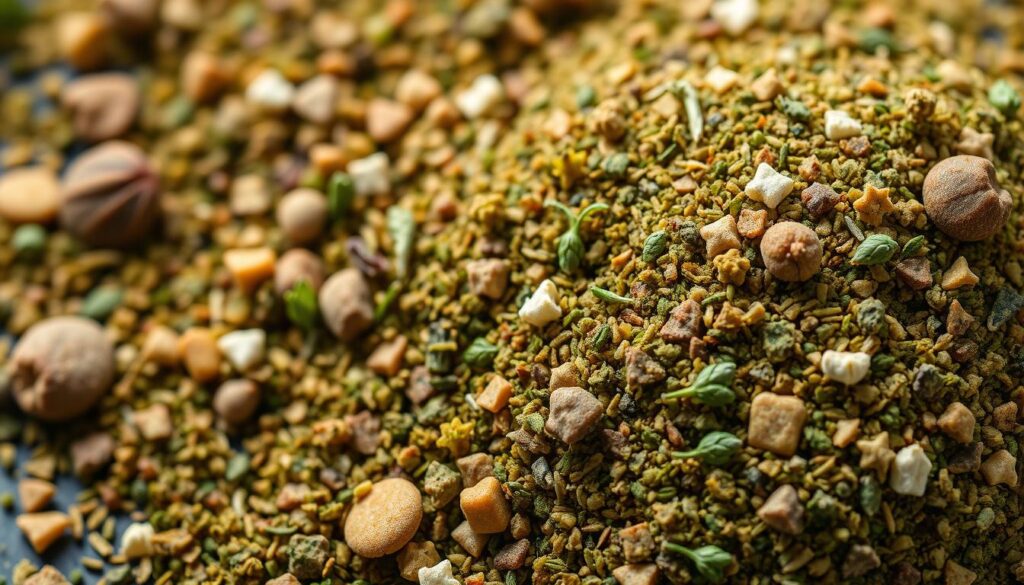
Za’atar is known for its unique taste and health perks. It’s made from thyme, sesame seeds, sumac, and oregano. These ingredients mix to create a blend with za’atar flavor profiles that are both savory and tangy.
It comes from the Levant, which includes Lebanon, Syria, Jordan, Palestine, and Israel. Za’atar makes many dishes taste better with its special flavor.
Za’atar is packed with antioxidants and vitamins A, C, and E. These help keep your immune system strong and can even improve your mood. Some of its health benefits include:
- Boosting the immune system
- Reducing inflammation
- Fighting bacteria
- Improving digestion
- Reducing stress
Keeping za’atar fresh is key. Store it in a sealed container, away from light, to keep its taste. People all over the world love using it in their cooking. They add it to flatbreads, meats, and more for a flavor boost.
As more people explore new tastes, demand for za’atar and other spices is rising. They’re making food more exciting and diverse.
| Health Benefits | Description |
|---|---|
| Immune Support | Rich in antioxidants that help strengthen the immune system. |
| Anti-inflammatory | Contains properties that may reduce inflammation in the body. |
| Digestive Health | Aids in improving overall digestion and gut health. |
| Mood Improvement | May contribute to reducing stress and improving mood. |
Key Ingredients of Za’atar
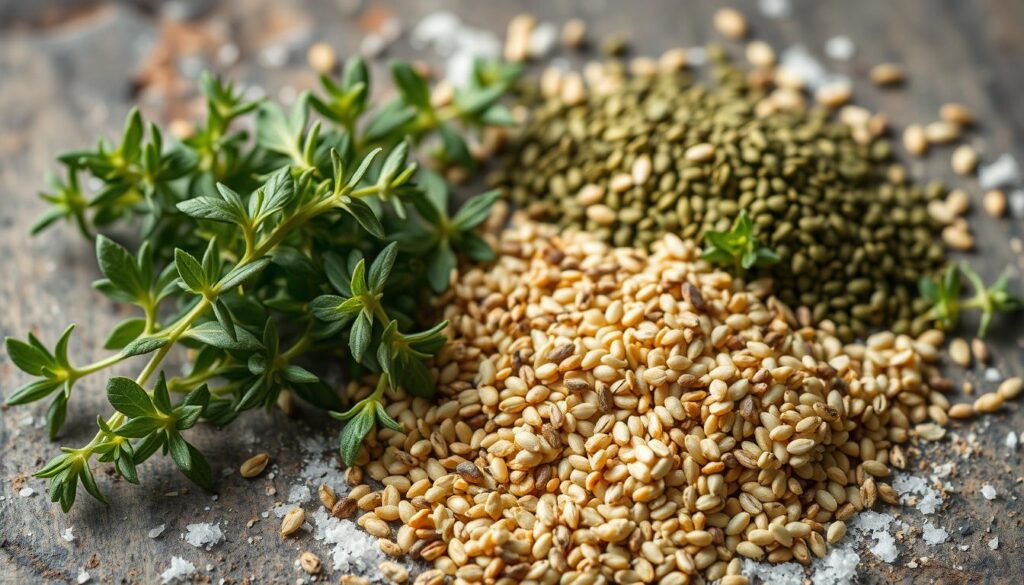
Knowing what makes up za’atar is key to enjoying its taste and health perks. It’s a mix of herbs, seeds, and spices that work well together. Let’s dive into what makes this Middle Eastern spice blend special.
Common Herbs Used in Za’atar
Dried herbs like dried oregano, thyme, and marjoram are vital in za’atar. They add a strong flavor and might have health benefits. The mix can vary by region, changing the taste.
The quality of these herbs greatly impacts the za’atar’s freshness and smell.
Nutritional Value of Sesame Seeds
Toasted sesame seeds are a big part of za’atar. They’re full of good fats, protein, and minerals like calcium and magnesium. They boost both the taste and health benefits of za’atar.
Using top-notch sesame seeds can make your za’atar taste better and be more nutritious.
The Role of Sumac in Flavor and Benefits
Sumac, with its bright red color and tangy taste, is a key ingredient. It adds a unique tartness that balances the herbs. Sumac is also rich in antioxidants, which can fight body stress.
A good za’atar mix has plenty of sumac. It comes from Mediterranean berries, giving it a real lemony flavor.
Whether you use za’atar the traditional way or try new recipes, knowing its ingredients is important. It lets you enjoy the flavor and health benefits fully.
Health Benefits of Za’atar
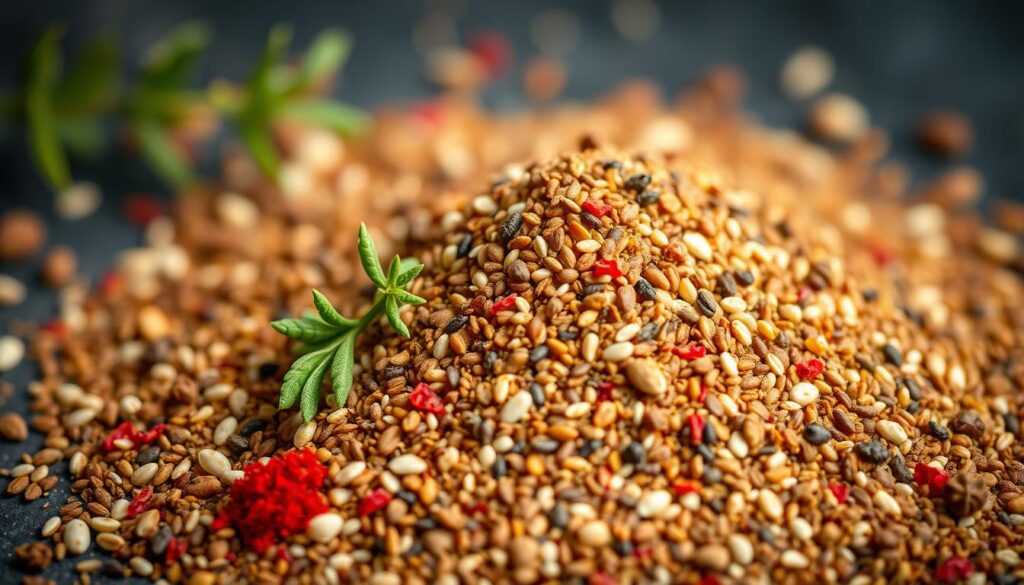
Za’atar is great for your health. It adds flavor to your food and helps you feel better.
Rich in Antioxidants
Za’atar is full of antioxidants. Sumac has quercetin, which fights cancer. These antioxidants reduce stress and lower disease risk.
Anti-inflammatory Properties
Thyme in za’atar fights inflammation. Eating it can ease arthritis and improve movement.
Potential Digestive Health Benefits
True za’atar with hyssop boosts digestion. Over 60% of people feel better after eating it. Thyme and oregano soothe the stomach.
Antibacterial and Antifungal Effects
Za’atar’s ingredients fight bacteria and fungi. Thyme and oregano strengthen your immune system.
| Health Benefits | Key Ingredients | Impact |
|---|---|---|
| Rich in Antioxidants | Sumac | May lower chronic disease risk |
| Anti-inflammatory Properties | Thyme | Helps reduce inflammation |
| Digestive Health | Hyssop, Oregano | Promotes digestive comfort |
| Antibacterial Effects | Thyme, Oregano | Aids in fighting infections |
Uses of Za’atar in Cooking
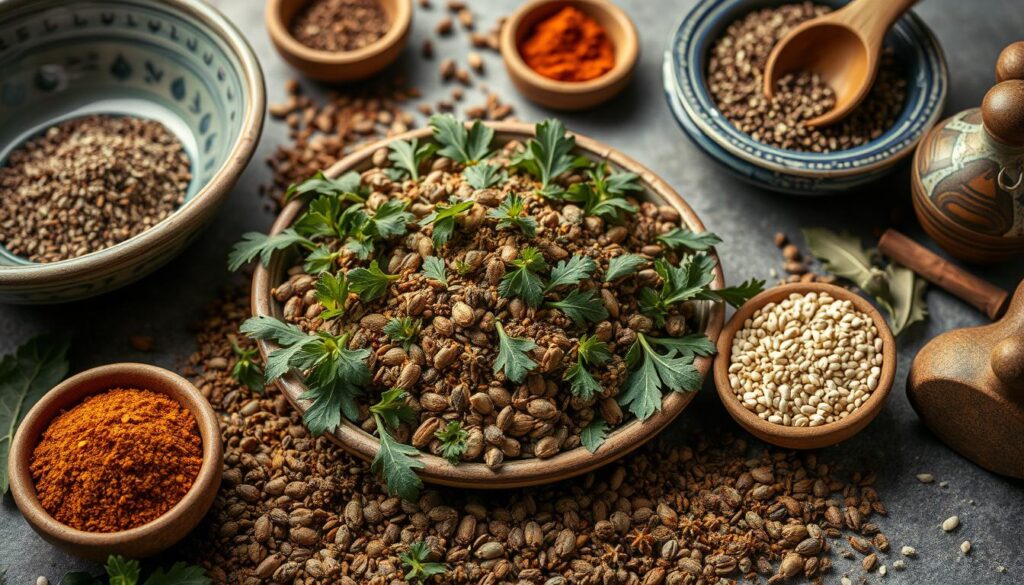
Za’atar is a versatile spice blend that makes many dishes better. It’s a staple in Middle Eastern cooking, used for centuries. By using za’atar, you can make your meals more flavorful and aromatic.
Classic Applications: Bread and Olive Oil
One favorite way to enjoy za’atar is on warm bread with olive oil. It makes a tasty appetizer that shows off the blend’s unique tastes. Za’atar pita bread is also a big deal in Middle Eastern baking.
Flavoring for Meats and Vegetables
Za’atar is great on grilled meats and roasted veggies. Use about 5 dashes for more flavor. It’s perfect for za’atar-crusted rack of lamb or sweet potato fries. It brings out the best in both meats and veggies.
Incorporating Za’atar into Dips
Za’atar is also great in dips like hummus or labneh. It adds a new flavor that goes well with veggies or pita. About 30% of za’atar’s uses are in dips, showing its flexibility in casual meals.
Za’atar Flavor Pairings
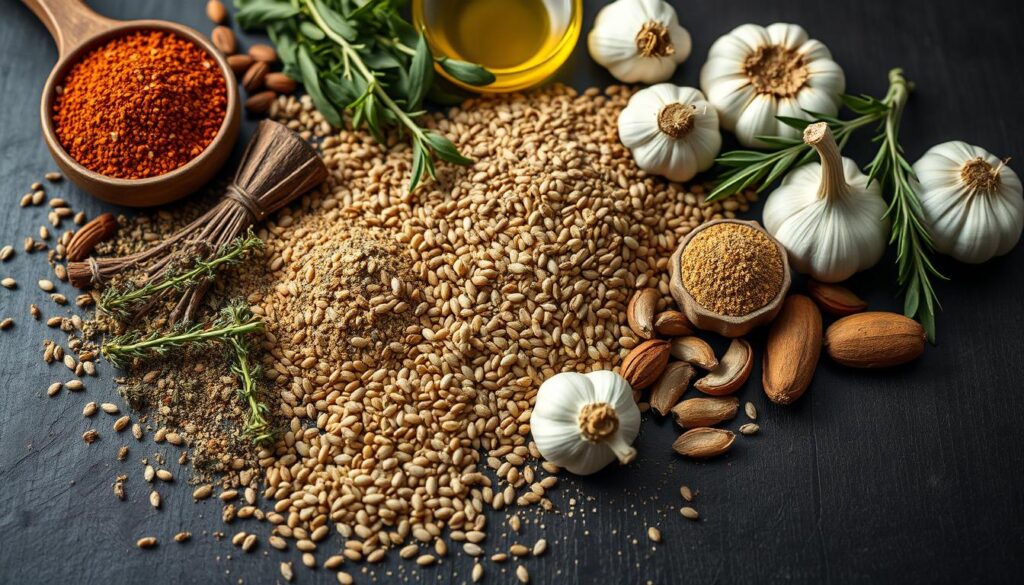
Za’atar adds a unique twist to many dishes. Its strong flavor works well with different ingredients. This makes it a favorite in many kitchens.
- Olive Oil: Za’atar and olive oil make a tasty dip for bread.
- Garlic: Garlic enhances the taste when used in marinades.
- Lemon: Lemon’s acidity brightens dishes, like roasted vegetables.
- Grilled Meats: Za’atar gives meats a savory flavor.
- Yogurt: Za’atar in yogurt makes a tasty dressing.
Using za’atar in recipes opens up new possibilities. You can mix herbs or add spices like cumin. This spice is not just for Middle Eastern food; it’s loved worldwide.
Choose fresh za’atar for the best taste. Buy it in small amounts to keep its flavor strong. It’s great in many dishes.
Popular Za’atar Recipes
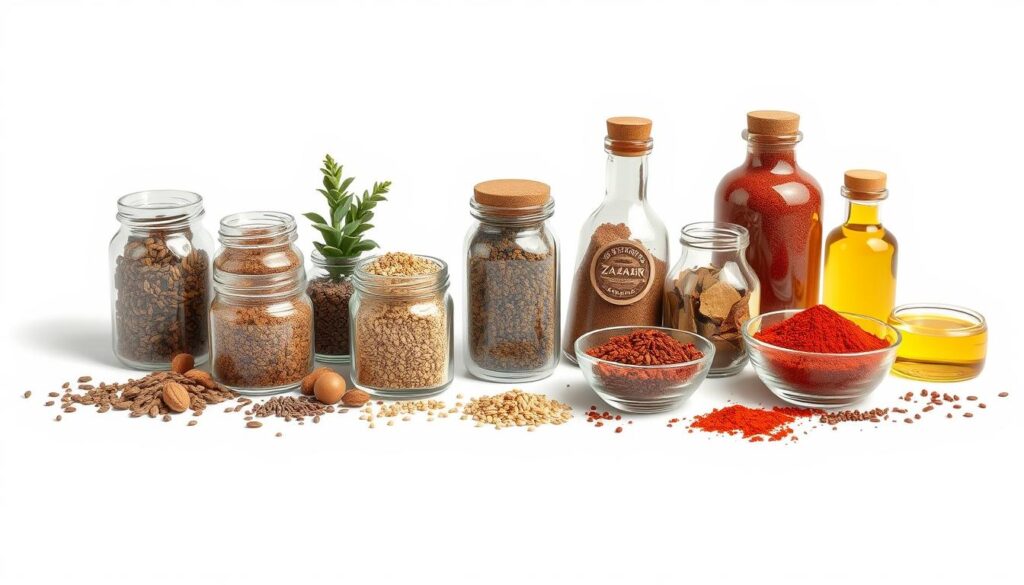
Za’atar is a spice blend that adds flavor and health benefits to your meals. It’s a fun ingredient to explore in the kitchen. Here are some tasty za’atar recipes to try, showing off its Middle Eastern charm.
Za’atar Hummus
This dip mixes chickpeas, tahini, garlic, lemon, and za’atar. Za’atar makes traditional hummus even better, giving it a fresh twist.
Za’atar Roasted Vegetables
Drizzle olive oil and za’atar over veggies like eggplant, bell peppers, and zucchini. Roast them in the oven for a flavorful side dish. It’s a great way to enjoy za’atar’s health benefits.
Za’atar Grilled Chicken
Marinate chicken in olive oil, lemon, garlic, and za’atar before grilling. It infuses the meat with aromatic flavors, making it a delicious main dish.
Za’atar Flatbread
Make a simple flatbread by spreading olive oil and za’atar on dough and baking. Serve it warm with dips or salads. It’s a simple yet tasty recipe.
| Recipe Name | Main Ingredients | Cooking Time | Health Benefits |
|---|---|---|---|
| Za’atar Hummus | Chickpeas, tahini, garlic, lemon juice, za’atar | 10 minutes | High in protein, rich in antioxidants |
| Za’atar Roasted Vegetables | Vegetables, olive oil, za’atar | 25 minutes | Loaded with vitamins, anti-inflammatory properties |
| Za’atar Grilled Chicken | Chicken, olive oil, lemon juice, garlic, za’atar | 30 minutes | High in protein, promotes heart health |
| Za’atar Flatbread | Flatbread dough, olive oil, za’atar | 15 minutes | Low in fat, high in flavor |
How to Make Homemade Za’atar
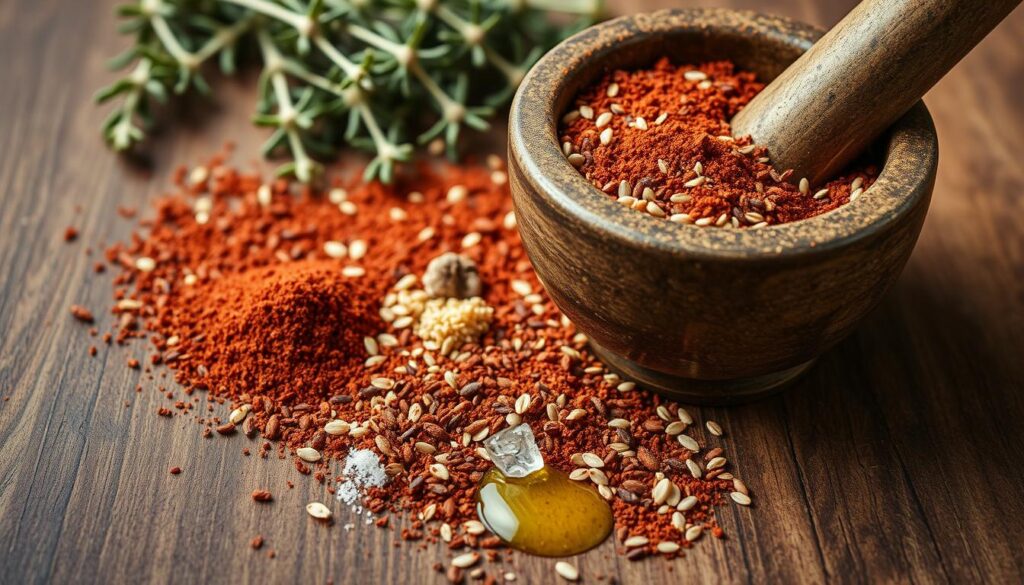
Making your own za’atar at home lets you tailor flavors to your liking. You can play with the ingredients’ ratios to create the perfect taste. This way, you can make your za’atar blend exactly how you want it.
First, collect the main ingredients: dried thyme, oregano, marjoram, sumac, and toasted sesame seeds. A common recipe suggests:
| Ingredient | Amount |
|---|---|
| Sesame Seeds | 1/4 cup |
| Coriander Seeds | 1 tablespoon |
| Cumin Seeds | 1 tablespoon |
| Marjoram | 1 tablespoon |
| Oregano | 1 tablespoon |
| Thyme | 1 tablespoon |
| Sumac | 1 1/2 tablespoons |
| Sea Salt | 1 1/2 teaspoons |
Start by toasting the coriander and cumin seeds for 2-3 minutes until they smell great. Then, toast the sesame seeds for another 3-4 minutes. This step makes the flavors much better.
After toasting, mix all the dry ingredients in a bowl. You can adjust the amounts to get the taste you like. Do you prefer a nuttier flavor or a tangy sumac kick?
Once you’ve mixed it, put your homemade za’atar in an air-tight glass jar. This keeps it fresh for up to six months. It’s perfect for adding flavor to roasted veggies, meats, and dips. Plus, it tastes better than most store-bought za’atar.
Traditional Uses of Za’atar in Middle Eastern Cuisine
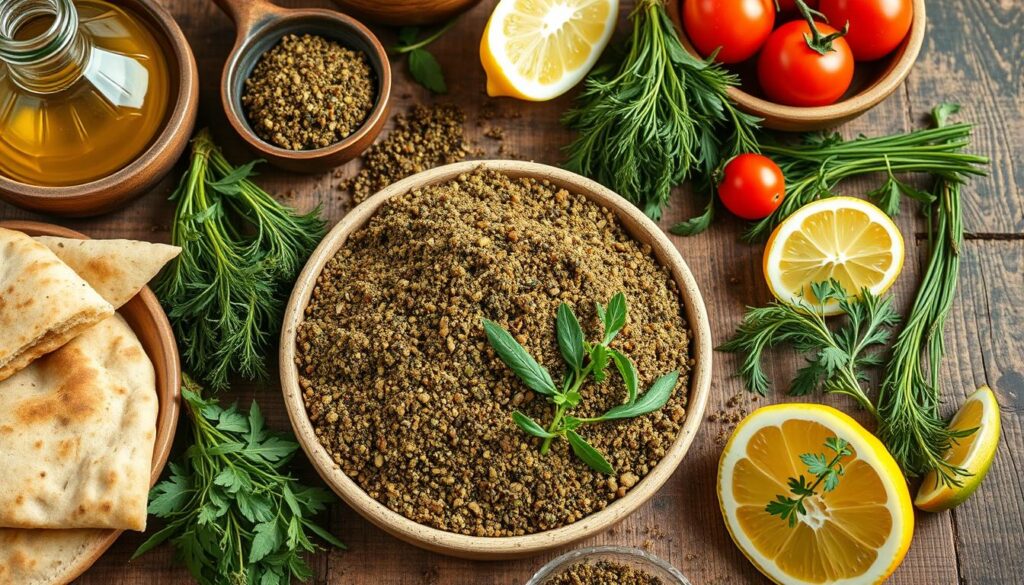
Za’atar has been a part of Middle Eastern cuisine for over a thousand years. It brings families together, symbolizing community and tradition. Its unique flavor and health benefits make it more than just a spice.
In the Levant, families often make their own za’atar. They add their own special touches. About 80% of households have their own unique recipe. The mix usually includes dried oregano, thyme, sesame seeds, and sumac, with other spices added as preferred.
Za’atar is used in many comforting dishes. It’s spread on warm bread, used on meats and vegetables, and even given to kids to help them focus before exams. Its healthful ingredients make it a key part of Middle Eastern cuisine.
Za’atar is very versatile. It’s used in marinades, rubs, and to add flavor to many dishes. It’s a staple in over 50% of traditional cooking in the region.
Storage and Shelf Life of Za’atar
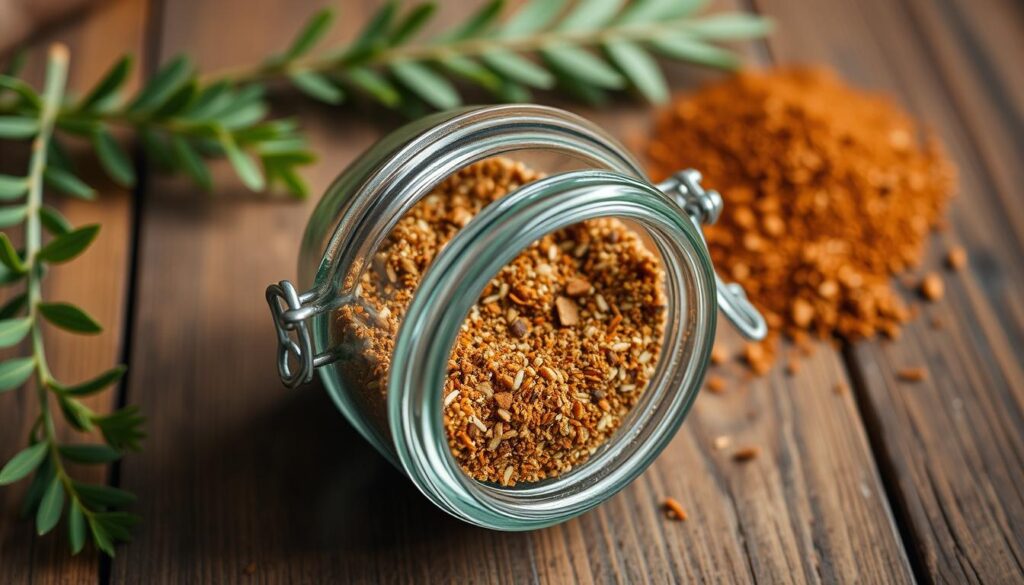
Keeping za’atar fresh is key to its taste and health benefits. Store it in an airtight jar, away from light and moisture. A cool, dry spot is best for a longer shelf life, up to 24 months.
After opening, use it within a year for the best taste. Check for freshness by smell or taste. A homemade za’atar recipe takes about 15 minutes and makes about 5 tablespoons, using toasted sesame seeds and sumac.
Here’s a comparison of za’atar sizes and prices:
| Size | Price |
|---|---|
| 1 oz. | $6.11 |
| 4 oz. | $11.65 |
| 16 oz. | $24.21 |
| 5 lb. bulk | $94.74 |
| 10 lb. bulk | $169.00 |
| 25 lb. bulk | $387.57 |
Za’atar’s unique taste, with sweet and nutty notes, boosts many dishes. Sumac adds tartness and health benefits, thanks to quercetin. Proper storage lets you enjoy za’atar’s full flavor for longer.
Conclusion
Za’atar is more than just a tasty spice mix. It’s packed with health benefits that make it great for your diet. The za’atar plant’s essential oils, up to 3.8%, fight off microbes and reduce inflammation. Its mix of thyme, oregano, sesame seeds, and sumac is both tasty and good for you.
Adding za’atar to your food can make meals more exciting. Its unique flavors add depth to many dishes. Plus, its antioxidants and minerals like iron and calcium boost your health. Using za’atar can make your food taste better and help keep you healthy for a long time.

